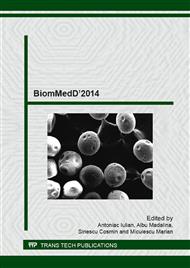p.270
p.274
p.280
p.286
p.296
p.303
p.310
p.316
p.322
Bisphosphonates vs. Atypical Femur Fractures - Influence on Bone Resorption
Abstract:
Bisphosphonates currently represent the main therapy in the fight against osteoporosis. This is a serious condition, with an increasing incidence, presently affecting about 12 million people in the U.S. mostly women aged over 50 years. Thus, approximately 40% -50% of them suffer an osteoporotic fracture. Bisphosphonates mechanism of action consists in reducing osteoclast-mediated bone resorption, modifying bone turn over, leading to an increase in bone density. This dramatically reduces the risk of fracture. Although bisphosphonates shows a good safety profile, lately emerged some alarm signals that link their long management to some unusual side effects. Bisphosphonates is an effective therapy to combat osteoporosis, their causal relationship with FAF production not being shown. In the absence of other evidence, it is unclear whether BF therapy is directly involved in producing FAF or only a component of a combination of factors, in reality being just an indicator of a severe degree of osteoporosis. In the same time, we must not forget that the FAF are very rare compared to the number of patients in therapy with BF and the number of typical femur fractures, and the risk / benefit ratio it is definitely in favor of the benefit.
Info:
Periodical:
Pages:
296-300
Citation:
Online since:
March 2015
Authors:
Keywords:
Price:
Сopyright:
© 2015 Trans Tech Publications Ltd. All Rights Reserved
Share:
Citation:


